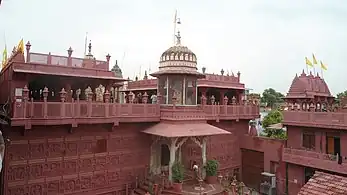Jaipur
Jaipur (/ˈdʒaɪpʊər/ ⓘ),[8][9][10] formerly Jeypore, is the capital and largest city of the Indian state of Rajasthan. As of 2011, the city had a population of 3.1 million, making it the tenth most populous city in the country. Jaipur is also known as the Pink City, due to the dominant colour scheme of its buildings. It is also known as the Paris of India, and C. V. Raman called it the Island of Glory. It is located 268 km (167 miles) from the national capital New Delhi. Jaipur was founded in 1727 by the Kachhwaha Rajput ruler Jai Singh II,[11][12] the ruler of Amer, after whom the city is named. It was one of the earliest planned cities of modern India, designed by Vidyadhar Bhattacharya.[13] During the British Colonial period, the city served as the capital of Jaipur State. After independence in 1947, Jaipur was made the capital of the newly formed state of Rajasthan.
Jaipur | |
|---|---|
| Nickname: The Pink City | |
| Coordinates: 26.9°N 75.8°E | |
| Country | |
| State | |
| District | Jaipur |
| Establishment | 1727 |
| Founded by | Jai Singh II |
| Named for | Jai Singh II |
| Government | |
| • Type | Municipal Corporation |
| • Body | Jaipur Municipal Corporation |
| • Mayor | • Somya Gurjar (Jaipur Greater)[1](BJP) • Munesh Gurjar (Jaipur Heritage)(Congress)[1] |
| Area | |
| • Total | 467 km2 (180 sq mi) |
| • Rank | 1st in Rajasthan |
| Elevation | 431 m (1,414 ft) |
| Population (2011)[3] | |
| • Total | 3,046,189 |
| • Rank | 10th India |
| • Density | 6,500/km2 (17,000/sq mi) |
| Demonyms | Jaipuri, Jaipuriya |
| Language | |
| • Official | Hindi, Rajasthani[4] |
| • Additional official | English[4] |
| • Regional | Dhundari[5] |
| Time zone | UTC+05:30 (IST) |
| Pincode(s) | 3020xx |
| Area code(s) | +91-141 |
| Vehicle registration | RJ-14 (Jaipur South) RJ-45 (Jaipur North) |
| GDP Nominal (Jaipur district) | ₹122,140 crore (US$15 billion)[6] |
| Budget | ₹895.60 crores ($121 million)[7] |
| Airport | Jaipur International Airport |
| Rapid transit system | Jaipur Metro |
| Website | jaipurmc (Jaipur Greater) jaipurmcheritage (Jaipur Heritage) |
| Official name | Jaipur City, Rajasthan |
| Criteria | Cultural: (ii), (iv), (vi) |
| Designated | 2019 (43rd session) |
| Reference no. | 1605 |
| Region | Southern Asia |
Jaipur is a popular tourist destination in India and forms a part of the west Golden Triangle tourist circuit along with Delhi and Agra (240 km, 149 mi).[14] It also serves as a gateway to other tourist destinations in Rajasthan such as Jodhpur, Jaisalmer, Bikaner, Udaipur, Kota and Mount Abu.
On 6 July 2019, UNESCO World Heritage Committee inscribed Jaipur the "Pink City of India" among its World Heritage Sites.[15][16] The city is also home to the UNESCO World Heritage Sites Amer Fort and Jantar Mantar.
Etymology
Jaipur derives its name from its founder, Sawai Jai Singh (1693-1744), a notable warrior and accomplished astronomer.[17][18] In Sanskrit, variations of the word "pur" or "pura" are commonly used to refer to a city or town. Therefore, "Jaipur" essentially means "The City of Jai" or "Jai's City," paying homage to Maharaja Jai Singh II, who established the city.
History

The city of Jaipur was founded by the King of Amber, Maharaja Sawai Jai Singh II on 18 November 1727, who ruled from 1699 to 1743. He planned to shift his capital from Amber, 11 kilometres (7 mi) to Jaipur to accommodate the growing population and increasing scarcity of water.[13] Jai Singh consulted several books on architecture and architects while planning the layout of Jaipur. Under the architectural guidance of Vidyadhar Bhattacharya, Jaipur was planned based on the principles of Vastu Shastra and Shilpa Shastra.[19] The construction of the city began in 1726 and took four years to complete the major roads, offices, and palaces. The architecture of the city was heavily influenced by the 17th century architectural renaissance during Mughal rule in Northern India. Hence much of it resembles architecture styles from around the Muslim world. The city was divided into nine blocks, two of which contained the state buildings and palaces, with the remaining seven allotted to the public. Huge ramparts were built, pierced by seven fortified gates.[13]
During the rule of Sawai Ram Singh II, the city was painted pink to welcome Albert Edward, Prince of Wales (who later became King Edward VII, Emperor of India), in 1876.[20] Many of the avenues still remain painted in pink, giving Jaipur a distinctive appearance and the epithet Pink city.[21]
In the 19th century, the city grew rapidly and by 1900 it had a population of 160,000. The wide boulevards were paved and its chief industries were the working of metals and marble, fostered by a school of art founded in 1868.[12] The city had three colleges, including a Sanskrit college (1865) and a girls' school (1867) opened during the reign of the Maharaja Ram Singh II.[22][23]
Large areas of the city including the airport were flooded in August 1981, resulting in the death of eight people and much damage to the city's Dravyavati River.[24] The floods were caused by three days of cloud burst that produced more rain than the annual average.[25]
Geography
Topography
Jaipur is located in the northeastern part of Rajasthan and covers a total area of 467 square kilometres (180 sq mi). The city is surrounded by fertile alluvial plains to the east and south and hill chains and desert areas to the north and west.[26][27] Jaipur generally slopes downwards from north to south and then to the southeast.[28] The city is surrounded by the Nahargarh hills in the north and Jhalana in the east, which is a part of the Aravalli range.[28]
Dravyavati river is the primary drainage channel which by 2014 had degenerated into an untreated sewage nallah. To address this issue, a contract for the rejuvenation of the river was awarded to a consortium comprising Tata Projects and the Shanghai Urban Construction Group by the JDA.[29] A 13-km stretch of Dravyavati riverfront out of 47.5 km was opened for residents in 2018[30] and the remaining project was completed in 2022.[31]
Climate
Jaipur has a monsoon-influenced hot semi-arid climate (Köppen climate classification BSh) with long, extremely hot summers and short, mild to warm winters. Annual precipitation is over 625 millimetres or 25 inches, falling mostly in July and August due to the southwest monsoon, causing the average temperatures in these two months to be lower compared to drier May and June. During the monsoon, there are frequent, heavy rains and thunderstorms, but flooding is not common. The highest temperature ever recorded was 49.0 °C (120.2 °F), on 23 May 1994. The city's average temperature remains below 20 °C or 68 °F between December and February. These months are mild, dry, and pleasant, sometimes chilly. The lowest temperature ever recorded was −2.2 °C (28.0 °F) on 31 January 1905, 1 February 1905 and 16 January 1964. Jaipur, like many other major cities of the world, is a significant urban heat island zone with surrounding rural temperatures occasionally falling below freezing in winters.[32]
| Climate data for Jaipur (Jaipur International Airport) 1981–2010, extremes 1952–2012 | |||||||||||||
|---|---|---|---|---|---|---|---|---|---|---|---|---|---|
| Month | Jan | Feb | Mar | Apr | May | Jun | Jul | Aug | Sep | Oct | Nov | Dec | Year |
| Record high °C (°F) | 31.7 (89.1) |
36.7 (98.1) |
42.8 (109.0) |
44.9 (112.8) |
49.0 (120.2) |
47.2 (117.0) |
46.7 (116.1) |
41.7 (107.1) |
41.7 (107.1) |
40.0 (104.0) |
36.4 (97.5) |
32.0 (89.6) |
49.0 (120.2) |
| Mean maximum °C (°F) | 27.2 (81.0) |
31.4 (88.5) |
37.1 (98.8) |
41.9 (107.4) |
44.3 (111.7) |
43.7 (110.7) |
39.4 (102.9) |
36.1 (97.0) |
37.5 (99.5) |
36.9 (98.4) |
33.1 (91.6) |
28.3 (82.9) |
44.8 (112.6) |
| Average high °C (°F) | 22.6 (72.7) |
25.7 (78.3) |
31.6 (88.9) |
37.4 (99.3) |
40.7 (105.3) |
39.6 (103.3) |
34.6 (94.3) |
32.7 (90.9) |
34.2 (93.6) |
33.8 (92.8) |
29.3 (84.7) |
24.5 (76.1) |
32.2 (90.0) |
| Average low °C (°F) | 8.6 (47.5) |
11.4 (52.5) |
16.8 (62.2) |
22.2 (72.0) |
26.5 (79.7) |
27.7 (81.9) |
26.1 (79.0) |
24.8 (76.6) |
23.6 (74.5) |
19.6 (67.3) |
14.0 (57.2) |
9.5 (49.1) |
19.2 (66.6) |
| Mean minimum °C (°F) | 3.8 (38.8) |
6.1 (43.0) |
11.3 (52.3) |
16.7 (62.1) |
20.9 (69.6) |
22.2 (72.0) |
23.1 (73.6) |
22.3 (72.1) |
20.8 (69.4) |
15.2 (59.4) |
9.1 (48.4) |
4.8 (40.6) |
3.5 (38.3) |
| Record low °C (°F) | −2.2 (28.0) |
−2.2 (28.0) |
3.3 (37.9) |
9.4 (48.9) |
15.6 (60.1) |
18.4 (65.1) |
20.6 (69.1) |
18.9 (66.0) |
15.0 (59.0) |
11.1 (52.0) |
3.3 (37.9) |
0.0 (32.0) |
−2.2 (28.0) |
| Average rainfall mm (inches) | 5.5 (0.22) |
4.9 (0.19) |
4.2 (0.17) |
8.2 (0.32) |
18.7 (0.74) |
68.8 (2.71) |
220.8 (8.69) |
194.8 (7.67) |
71.4 (2.81) |
20.1 (0.79) |
5.3 (0.21) |
3.8 (0.15) |
626.5 (24.67) |
| Average rainy days | 0.6 | 0.9 | 0.7 | 0.9 | 1.3 | 4.2 | 9.8 | 9.4 | 4.8 | 1.2 | 0.2 | 0.3 | 34.3 |
| Average relative humidity (%) (at 17:30 IST) | 37 | 29 | 21 | 17 | 19 | 33 | 60 | 67 | 50 | 31 | 34 | 39 | 36 |
| Average dew point °C (°F) | 6 (43) |
7 (45) |
7 (45) |
8 (46) |
12 (54) |
19 (66) |
24 (75) |
24 (75) |
21 (70) |
13 (55) |
9 (48) |
6 (43) |
13 (55) |
| Average ultraviolet index | 5 | 7 | 9 | 11 | 12 | 12 | 12 | 12 | 10 | 8 | 6 | 5 | 9.1 |
| Source 1: India Meteorological Department[33][34][35] Climate of Jaipur[36] Time and Date (dewpoints, 2005–2015)[37] | |||||||||||||
| Source 2: Weather Atlas[38] | |||||||||||||
Demographics
| Year | Pop. | ±% |
|---|---|---|
| 1881 | 142,600 | — |
| 1891 | 158,900 | +11.4% |
| 1901 | 160,000 | +0.7% |
| 1911 | 137,100 | −14.3% |
| 1921 | 120,200 | −12.3% |
| 1931 | 144,200 | +20.0% |
| 1941 | 175,800 | +21.9% |
| 1951 | 291,000 | +65.5% |
| 1961 | 403,400 | +38.6% |
| 1968 | 533,200 | +32.2% |
| 1971 | 636,800 | +19.4% |
| 1981 | 1,004,700 | +57.8% |
| 1991 | 1,518,200 | +51.1% |
| 2001 | 2,322,575 | +53.0% |
| 2011 | 3,073,350 | +32.3% |
| Source: Census of India[39][40][41] | ||
According to the provisional report of 2011 census, Jaipur city had a population of 3,073,350.[41] The overall literacy rate for the city is 84.34%. 90.61% males and 77.41% females were literate.[41] The sex ratio was 898 females per 1,000 males & the child sex ratio was recorded 854.[41] However, the population of the city is expected to grow up to around 39.1 lakhs (3.91 million).
Governance and politics

Civic administration
The Jaipur Municipal Corporation (JMC) was established in the year 1994.[44] The area of the municipal corporation is 467 square km[2] and it is governed under the Rajasthan Municipality Act of 1959.[44] The municipal corporation is headed by a mayor.[45]
JMC was recently bifurcated into two Municipal Corporations, namely Greater Jaipur Municipal Corporation and Jaipur Heritage Municipal Corporation.[46] Originally, the municipality had 91 wards and each ward was represented by an elected member. However, the Local Self Government Department of Rajasthan divided Jaipur into two municipal corporations, namely Greater Jaipur Municipal Corporation and Heritage Jaipur Municipal Corporation, with 150 and 100 wards each, respectively.[47]
The latest elections were held in October 2020, which were postponed due to COVID-19.[48] However, elections for the 100 wards of Jaipur Heritage Municipal Corporation were held on 29 October 2020.[49]
The mayor is the elected representative of the city. The current mayor of Jaipur Municipal Corporation (Greater) is Smt. Somya Gurjar since 10 November 2020 and the mayor for Jaipur Municipal Corporation (Heritage) is Smt. Munesh Gurjar since 10 November 2020.[50] The administration duties are carried out by the municipal commissioner and his group of officials. The municipal commissioner of Jaipur is Mahendra Soni (IAS).
The estimated municipal budget for the year 2022–23 is ₹8950 lakhs.[7] The key revenue sources for Jaipur municipality are taxes which include House tax, Urban Development tax and octroi compensation. Along with this it also gains revenue from various fees and user charges.[7] The masterplan for the city 2025 was created by the Jaipur Development Authority.[51]
Legislative assembly and state agencies
Jaipur consists of two parliamentary constituencies Jaipur and Jaipur Rural.[52] The political party with a majority in Jaipur is the Indian National Congress. It also has electives from the BJP and INC.[53]
The Jaipur Lok Sabha constituency comprises eight Vidhansabha (legislative assembly) segments, all of which fall partly in Jaipur city.[54] MLA for Hawa Mahal is Mahesh Joshi from INC, MLA for Vidhyadhar Nagar is Narpat Singh Rajvi from BJP, MLA for Civil Lines is Pratap Singh Khachariyavas from INC, MLA for Kishanpole is Amin Kagzi from INC, MLA for Adarsh Nagar is Rafeek Khan from INC,[55][56] MLA for Malviya Nagar constituency is Kalicharan Saraf from BJP, MLA for Sanganer constituency is Ashok Lahoty from BJP and lastly the MLA for Bagru is Ganga Devi from INC.[55][56]
The city police in Jaipur is under the jurisdiction of the Rajasthan State Department.[57] The current Police Commissioner for Jaipur City Police is Anand Srivastava.[58] In Jaipur City, there is a District and Sessions court present. It also has a family court.[59]
The District Collector or District Magistrate for Jaipur City is Prakash Rajpurohit.[60]
Civic utilities
Jaipur Development Authority (JDA) is the nodal government agency responsible for the planning and development of Jaipur. Jaipur also falls under the Jaipur district of the state of Rajasthan in western India. There are 13 tehsils in the district, which are named Jaipur, Amer, Bassi, Chaksu, Chomu, Mojmabad, Jamwa Ramgarh, Phage, Phulera, Kotputli, Sanganer, Shahpura, Viratnagar. The total area of the district is 14068 square km.[61]
Jaipur Municipal Corporation is responsible for maintaining the city's civic infrastructure and carrying out associated administrative duties.[62]
Electricity in Jaipur City is supplied through Jaipur Vidyut Vitaran Nigam LTD(JVVNL) by the Government of Rajasthan.[63] Jaipur MC has a fire department wing and there are 11 fire stations, with 50 fire tenders in the state capital. However, with the city is expanding and the population increasing, the existing infrastructure is not sufficient to cater to the city's requirements.[64] Jaipur, a Tier 2 city, also does not have rescue tenders, used for cutting material, or a turntable ladder (TTL), used for dousing flames from aerial angles without entering the building.[64]
Water supply, sewerage and drainage
The Rajasthan government has formed the Jaipur Water Supply and Sewerage Board (JWSSB) for the management of water supply and sewerage services in urban areas of the city. JWSSB, an autonomous body, has been constituted under the JWSSB Ordinance, 2018.[65] It will ensure water supply as per the standards stipulated by the Bureau of Indian Standards, the State Pollution Control Board or Rajasthan's Public Health Engineering Department (PHED).[65] JWSSB will be responsible for financing, designing, constructing, altering, repairing, operating, and maintaining various water supply and sewerage schemes. It will also provide meters and carry out commercial services such as meter reading, billing, and revenue collection.[65]
The Jaipur Development Authority has divided the city into four main drainage zones with the northern and central zones draining into the Dravyavati river while the western zone drains into the Chandler lake and the eastern and southern areas combined drain into the Dhundh River.[66] Sewerage systems and STPs have been constructed accordingly with the installed capacity being 730 km of sewer lines and 442 MLD of sewage treatment.[67]
Solid waste management
The corporation has a new solid waste management system that includes door-to-door collection, transportation of garbage in covered vehicles, proper deployment of dustbins, use of modern equipment.[68] The system ensures private investment as well as public participation with a small amount of monthly user charges. The size of the JMC garbage can be kept at a manageable level.[68]
Complete Sanitation work in 3 zones, namely, Hawamahal Zone (East), Hawamahal (West), Motidungari Zone, and Pratap Nagar has been contracted out through National Tendering.[68]
Tourism
Jaipur is a major tourist destination in India forming a part of the Golden Triangle.[69] In the 2008 Conde Nast Traveller Readers Choice Survey, Jaipur was ranked the 7th best place to visit in Asia.[70] According to TripAdvisor's 2015 Traveller's Choice Awards for Destination, Jaipur ranked 1st among the Indian destinations for the year.[71] The Presidential Suite at the Raj Palace Hotel, billed at US$45,000 per night, was listed in second place on CNN's World's 15 most expensive hotel suites in 2012.[72]
Jaipur Exhibition & Convention Centre (JECC) is Rajasthan's biggest convention and exhibition centre.[73] It is famous for organising events such as Vastara, Jaipur Jewellery Show, Stonemart 2015 and Resurgent Rajasthan Partnership Summit 2015.[74]
Visitor attractions include the Birla Auditorium, Albert Hall Museum, Hawa Mahal, Jal Mahal, City Palace, Amer Fort, Jantar Mantar, Nahargarh Fort, Jaigarh Fort, Birla Mandir, Galtaji, Govind Dev Ji Temple, Garh Ganesh Temple, Moti Dungri Ganesh Temple, Sanghiji Jain temple and the Jaipur Zoo.[75] The Jantar Mantar observatory (The Jantar Mantar is a collection of 19 astronomical instruments remarkable at their time.) and Amer Fort are one of the World Heritage Sites.[76] Hawa Mahal is a five-storey pyramidal shaped monument with 953 windows[77] that rises 15 metres (50 ft) from its high base. Sisodiya Rani Bagh and Kanak Vrindavan are the major parks in Jaipur.[78] Raj Mandir is a notable cinema hall in Jaipur.
Jaipur now has options to view the entire city via a Hot Air Balloon ride.[79]
Travel+Leisure – The World's Best Awards 2020
Jaipur was ranked Number 8 in "The Top 15 Cities in Asia".[80]
Culture
Jaipur has many cultural sites like Jawahar Kala Kendra formed by Architect Charles Correa and Ravindra Manch. Government Central Museum hosts several arts and antiquities. There is a government museum at Hawa Mahal and an art gallery at Viratnagar. There are statues depicting Rajasthani culture around the city.[81][82] Jaipur has many traditional shops selling antiques and handicrafts, as well as contemporary brands reviving traditional techniques, such as Anokhi. The prior rulers of Jaipur patronised a number of arts and crafts. They invited skilled artisans, artists and craftsmen from India and abroad who settled in the city. Some of the crafts include bandhani, block printing, stone carving and sculpture, tarkashi, zari, gota-patti, kinari and zardozi, silver jewellery, gems, kundan, meenakari and jewellery, Lakh ki Chudiya, miniature paintings, blue pottery, ivory carving, shellac work and leather ware.[83][78]
Jaipur has its own performing arts. The Jaipur Gharana for Kathak is one of the three gharanas of the major north Indian classical dance form of Kathak.[84] The Jaipur Gharana of Kathak is known for its rapid intricate dance forms, vivacious body movements and subtle Abhinaya.[84] The Ghoomar is a popular folk dance style.[85][86][87] Tamasha is an art form where Kathputli puppet dance is shown in play form.[42] Major festivals celebrated in Jaipur include Elephant Festival, Gangaur, Makar Sankranti, Holi, Diwali, Vijayadashami, Teej, Eid, Mahavir Jayanti and Christmas. Jaipur is also famous for the Jaipur Literature Festival, the world's largest free literature festival in which authors, writers and literature lovers from all over the country participate.[88]
Architecture
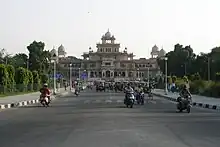
The city was planned according to the Indian Vastu shastra by Vidyadhar Bhattacharya in 1727.[89] There are three gates facing east, west, and north. The eastern gate is called Suraj pol (sun gate), the western gate is called Chand pol (moon gate) and the northern gate faces the ancestral capital of Amer.[19][90]
The city is unusual among pre-modern Indian cities in the regularity of its streets, and the division of the city into six sectors by broad streets 34 m (111 ft) wide. The urban quarters are further divided by networks of gridded streets. Five-quarters wrap around the east, south, and west sides of a central palace quarter, with a sixth quarter immediately to the east. The Palace quarter encloses the Hawa Mahal palace complex, formal gardens, and a small lake. Nahargarh Fort, which was the residence of the King Sawai Jai Singh II, crowns the hill in the northwest corner of the old city.[78]
Cuisine

Typical dishes include Dal Baati Churma, Missi Roti, Gatte ki Sabzi, Lahsun ki chutney, Ker Sangri, Makke ki Ghat, Bajre ki Ghat, Bajre ki Roti and Laal Maans.[91] Jaipur is also known for its sweets which include Ghevar, Feeni, Mawa Kachori, Gajak, Meethi thuli, Chauguni ke laddu, and Moong Thal.[92][93]
Economy

As per the official records released by the Directorate of Economics and Statistics (Rajasthan), the GDP(nominal) of Jaipur district is estimated at INR 1,22,140 crores ($15.8 billion) in 2020–21, with a per-capita GDP of INR 1,41,305.[94] In addition to its role as the provincial capital, educational, and administrative centre, the economy of Jaipur is fuelled by tourism, gemstone cutting, the manufacture of jewellery and luxury textiles, and information technology.[95]
Three major trade promotion organisations have their offices in Jaipur. These are: Federation of Indian Chambers of Commerce & Industry, (FICCI) the PHD Chamber of Commerce and Industry (PHDCCI) and the Confederation of Indian Industry (CII) which has its regional offices here. In 2008, Jaipur was ranked 31 among the 50 Emerging Global Outsourcing cities.[96] Jaipur Stock Exchange was one of the regional stock exchanges in India and was founded in 1989 but was closed in March 2015.[97]
Jaipur has emerged as a hub of automotive industries. JCB, Hero MotoCorp and Robert Bosch GmbH have their manufacturing plants in Jaipur.[98][99][100] Chemical manufacturers in the city are Aro Granite and Emami Agrotech. National Engineering Industries have a plant in Jaipur.[101]
The city is among top emerging IT hubs of India along with Ahmedabad, Bhubaneswar and Kochi. Mahindra World City is an integrated business zone in Jaipur. It is home to several software and IT companies including Genpact, Appirio, Infosys, Wipro, ICICI Bank, Connexions and Deutsche Bank.[102][103] The Government of Rajasthan have built Asia's largest incubator in Jaipur – the Bhamashah Techno Hub.[104]
Jaipur is a major hub for arts and crafts. It has many traditional shops selling antiques, jewellery, handicrafts, gems, bangles, pottery, carpets, textiles, leather and metal products. Jaipur is one of India's largest manufacturers of hand-knotted rugs.[105][106] Jaipur foot, a rubber-based prosthetic leg for people with below-knee amputations, was designed and is produced in Jaipur.[107][108] World Trade Park Jaipur, is a shopping mall in Jaipur opened in 2012.
Communication
Jaipur has offices of companies like Airtel, Jio, VI (Vodafone-Idea) and BSNL which are providing mobile telephony and there are also various internet service providers in the city. The government of Rajasthan has started free WiFi at various public places like Central Park, Jantar Mantar among others. Rajasthan's first ISP Data Ingenious Global Limited still providing large number of broadband customers and email services in entire Jaipur.[109]
Broadband Services
Jaipur has got a good network of broadband services both in Old Jaipur and New Jaipur. Jaipur is served by BSNL FTTH, Tata Play Fiber, ACT, Data Ingenious, Jio and Airtel.
Media
Major daily newspapers in Jaipur include Amar Ujala,[110] Rajasthan Patrika, Dainik Bhaskar, Indian Express, Dainik Navajyoti and The Times of India.[111] The state-owned All India Radio is broadcast both on the medium wave and FM band in the city. Private FM stations include Radio Mirchi (98.3 MHz), Radio City (91.1 MHz), My FM (94.3 MHz), FM Tadka 95 FM (95.0 MHz), Mirchi Love (104.0 MHz), Red FM 93.5 (93.5 MHz) and Gyan Vani (105.6 MHz). The city has a community FM channel in FM Radio 7 (90.4 MHz) by India International School Institutional Network. The public broadcaster Doordarshan (Prasar Bharati) provides a regional channel in addition to the private broadcasters.
Transport
Roads
Jaipur is located on National Highway No.48 connecting Delhi and Mumbai. National Highway 52 links Jaipur with Kota and National Highway 21 links Jaipur with Agra. RSRTC operates bus service to major cities in Rajasthan, New Delhi, Uttar Pradesh, Haryana, Madhya Pradesh, Maharashtra, Punjab and Gujarat. City buses are operated by Jaipur City Transport Services Limited (JCTSL)[113] of RSRTC.[114] The service operates more than 400 regular and low-floor buses. Major bus depots are located at Vaishali Nagar, Vidyadhar Nagar and Sanganer.
Jaipur BRTS was approved by the government in August 2006. Jaipur BRTS is managed by JCSTL, a special purpose vehicle formed by Jaipur Development Authority and Jaipur Nagar Nigam. In Phase I, two corridors have been proposed: a "North-South Corridor" from Sikar Road to Tonk Road and an "East-West Corridor" from Ajmer Road to Delhi Road. A section of the North-South Corridor from bypass near Harmada to Pani Pech became operational in 2010.[115][116]
Jaipur Ring Road is a project of Jaipur Development Authority to reduce increasing traffic of Jaipur city[117] which connects NH-21 (Agra Road), NH-48 (Ajmer Road), NH-52 (Tonk Road), and NH-52 (Malpura Road) having a length of 150 km.[118] The 57 km out of 150 km long six-lane Jaipur Ring Road has been completed at a cost of Rs. 1217 crore which was inaugurated by Sushma Swaraj, Arun Jaitley and Nitin Gadkari.
Bhawani Singh Road, named after the last Maharaja of Jaipur which begins from Nehru Sahkar Bhawan and ends at the intersection where Birla Mandir is situated is one of the most popular roads in the city with notable places like Rambagh Palace, Golf Club and Jaipur Development Authority Office falling on its path. A similarly named road; Bhawani Singh Lane, serves as a place where the prominent people of Jaipur reside. The road also serves as a passage for the offices of companies like ETV Rajasthan, Redington India Limited, Hal Clyde Denison, and Rajasthan Tourism Bureau.[119]
Rail
Jaipur is the headquarters of Jaipur Railway division and North Western Railway Zone of Indian Railways.[120] Jaipur Junction is the busiest station in Rajasthan with more than 45,000 passengers daily.[121]
Metro

Jaipur Metro commenced commercial operation on 3 June 2015.[122] Phase-1A is operational between Mansarovar and Chandpole consisting of nine stations namely Mansarovar, New Aatish Market, Vivek Vihar, Shyam Nagar, Ram Nagar, Civil Line, Railway Station, Sindhi Camp and Chandpole.[123] The Phase-1B was constructed with an estimated cost of ₹97.32 billion ($1.74 billion).[124] It became operational on 23 September 2020.[125][126]
Airport
Jaipur International Airport is in Sanganer, 12.2 km (8 miles) from the centre. The airport handled 363,899 international and 2,540,451 domestic passengers in 2015–2016.[127] Jaipur Airport also provides air cargo services. During winter, sometimes flights towards Indira Gandhi International Airport are diverted to Jaipur Airport due to heavy fog in Delhi.[128]
Education

Public and private schools in Jaipur are governed by the Central Board of Secondary Education or Board of Secondary Education, Rajasthan, International Board of education and follow a "10+2" plan. This plan entails eight years of primary education and four years of secondary education. The secondary school includes two years of upper secondary education, which is more specific and diverse than the two years of lower secondary education before it.[129] Languages of instruction include English and Hindi.
Notable institutions in the city are:
- University of Rajasthan
- Rajasthan University of Health Sciences
- Dr. Bhimrao Ambedkar Law University
- Rajasthan Sanskrit University
- Haridev Joshi University of Journalism and Mass Communication
- Suresh Gyan Vihar University
- Malaviya National Institute of Technology
- LNM Institute of Information Technology
- University of Technology
- National Institute of Ayurveda
- Sawai Man Singh Medical College
- Subodh College
- Vedic Kanya College
There are several digital marketing institutes in Jaipur As EIIM, Digilearning, Quibus training to name a few.
Admission to Engineering colleges in Jaipur, many of which are affiliated to Rajasthan Technical University (Kota), is through Rajasthan Engineering Admission Process. Some of the colleges that are affiliated to Rajasthan Technical University are Maharishi Arvind Institute of Engineering & Technology, Poornima College of Engineering, Arya Group of Colleges.
Sports
The main cricket stadium in the city, Sawai Mansingh Stadium, has a seating capacity of 30,000 and has hosted national and international cricket matches.[130] It is also the home ground of IPL team Rajasthan Royals. Sawai Mansingh Indoor Stadium, Chaugan Stadium and Railway Cricket Ground are the other sporting arenas in the city.
A new stadium has been proposed for Chonp Village with a seating capacity 75,000. It would be the third-largest cricket stadium in the world after the Sardar Patel Stadium and the Melbourne Cricket Ground.
The city is represented in the IPL by Rajasthan Royals (2008–2016; 2018–present)[131][132] and in Pro Kabaddi League by Jaipur Pink Panthers.[133]
A new cricket stadium located 27 km from Jaipur is under construction. In July 2021, Chief Minister Ashok Gehlot said that the stadium will have a total seating capacity of 75000 and will be constructed in two phases, of which the seating accommodation of 45,000 people will be completed in the first phase and expansion for another 30,000 will be done in the second phase.[134][135]
In popular culture
Paul McCartney wrote and recorded the Jaipur tribute song "Riding into Jaipur" (4:08) whose minimalist lyrics say: « riding to Jaipur, riding through the night, riding with my baby, oh what a delight, oh what a delight, it is. » The song was released on his 2001 studio album Driving Rain.
Jaipur is the setting for the film The Best Exotic Marigold Hotel and its sequel, The Second Best Exotic Marigold Hotel, which follow the adventures of a group of senior European ex-pats who retire to Jaipur and in the process discover their true selves.
Notable people
- Ila Arun
- Asrani, Indian actor
- Smita Bansal, Indian actress
- Daulat Mal Bhandari
- Vikrant Bhargava
- Vishwa Mohan Bhatt
- Apurvi Chandela
- Ajay Data, Indian entrepreneur
- Gayatri Devi ( 23 May 1919 – 29 July 2009), Maharani of Jaipur
- Anshu Jain (1963–2022), banker
- Syed Akbar Jaipuri (1928–1998), Urdu poet from Jaipur
- Hasrat Jaipuri (1922–1999), Urdu-Hindi poet and Bollywood lyricist
- Mungtu Ram Jaipuria, Indian industrialist and educationist, son of Anandaram Jaipuria and the founder of Seth Anandram Jaipuria College and Seth M.R. Jaipuria Schools including Seth Anandram Jaipuria School Lucknow
- Rajaram Jaipuria (1934–2015), Indian industrialist and educationist, son of Mungtu Ram Jaipuria
- Ravi Jaipuria, Indian businessman
- Sitaram Jaipuria (1926–1985), Indian politician
- Irrfan Khan, Indian actor in Bollywood, British and American films
- Habib Miyan, claimed to be the oldest man in the world
- Aditya J Patwardhan, film producer and director.
- Ravi Kumar Punia, football player
- Jesse Randhawa
- Kamal Singh Saroha, owner of Rajasthan United FC
- Man Singh II (21 August 1912 – 24 June 1970)
- Ashish Sharma
- Shubhi Sharma, Indian actress who is active mainly in Bhojpuri-language films[136][137]
- Sunil Vaswani
- Hafiz Salahuddin Yusuf
References
- "पोर्टल, राजस्थान सरकार". jaipur.rajasthan.gov.in. Archived from the original on 18 March 2023. Retrieved 18 March 2023.
- "City Profile". Jaipur Municipal Corporation. Archived from the original on 25 April 2018. Retrieved 24 April 2018.
- "District Census Handbook – Jaipur" (PDF). Census of India. p. 30. Archived (PDF) from the original on 14 November 2015. Retrieved 10 February 2016.
- "52nd Report of the Commissioner for Linguistic Minorities in India" (PDF). nclm.nic.in. Ministry of Minority Affairs. Archived from the original (PDF) on 25 May 2017. Retrieved 2 May 2019.
- "Glottolog 4.1 – Dhundari". glottolog.org. Retrieved 7 January 2020.
- Records, Official. "Year Wise Gross Domestic Product at Current Price of JAIPUR". Government of Rajasthan Directorate of Economics & Statistics District Domestic Produc. Retrieved 6 November 2021.
- "Presentation of JMC budget".
- "Jaipur City (or Jainagar)". The Imperial Gazetteer of India. 1909. pp. 399–402. Archived from the original on 26 May 2010. Retrieved 23 April 2010.
- "Define Jaipur". Dictionary.com. Archived from the original on 14 July 2014. Retrieved 26 June 2014.
- "Definition of Jaipur". The Free Dictionary. Archived from the original on 7 July 2014. Retrieved 26 June 2014.
- Sen, Sailendra Nath (2007). Textbook of Indian History and Culture. New Delhi: MACMILLAN. p. 167. ISBN 978-1-4039-3200-6.
- Chisholm, Hugh, ed. (1911). . Encyclopædia Britannica. Vol. 15 (11th ed.). Cambridge University Press. pp. 128–129.
- "About Jaipur". Government of Rajasthan. Archived from the original on 3 November 2015. Retrieved 5 November 2015.
- "The Complete Guide To: India's Golden Triangle". The Independent. 3 February 2007. Archived from the original on 30 December 2017. Retrieved 15 December 2017.
- "Top 5 places to visit in Jaipur". Business Insider. 16 June 2023. Retrieved 10 August 2023.
- "Seven cultural sites inscribed on UNESCO's World Heritage List". UNESCO. 6 July 2019. Retrieved 10 August 2023.
- Sarkar, Jadunath (1984). A History of Jaipur: C. 1503-1938. Orient Blackswan. ISBN 978-81-250-0333-5.
- Bhatt, Rajendra Shankar (2005). Sawai Jai Singh. National Book Trust, India. pp. 101, 123, 155. ISBN 978-81-237-4418-6.
- "Jaipur – The Pink City". Archived from the original on 17 July 2011. Retrieved 5 July 2011.
- "History of Jaipur". Lonely Planet. Archived from the original on 1 June 2016. Retrieved 26 April 2016.
- "History in depth: Edward VII: The First Constitutional Monarch". BBC. 5 November 2009. Archived from the original on 26 June 2007. Retrieved 26 July 2010.
- "Jaipur City or Jainagar". The Imperial Gazetteer of India. 1909. pp. 399–402. Archived from the original on 26 May 2010. Retrieved 23 April 2010.
- "Jaipur State". The Imperial Gazetteer of India. 1909. pp. 382–399. Archived from the original on 15 November 2015. Retrieved 5 November 2015.
- "Rejuvenation of Amanishah Nallah including Area Development" (PDF). Ministry of Environment, Forest and Climate Change. 5 May 2016. p. 25. Archived (PDF) from the original on 1 February 2018. Retrieved 31 January 2018.
- Jain, Sharad K.; Agarwal, Pushpendra K.; Singh, Vijay P. (2007). Hydrology and Water Resources of India. Springer Science & Business Media. p. 883. ISBN 978-1-4020-5180-7. Archived from the original on 1 February 2018. Retrieved 31 January 2018.
- "Jaipur | History, Map, Population, & Facts | Britannica". www.britannica.com. Retrieved 16 March 2023.
- Centre, UNESCO World Heritage. "Jaipur City, Rajasthan". UNESCO World Heritage Centre. Retrieved 16 March 2023.
- "Jaipur Nagar Nigam (Greater)". jaipurmc.org. Retrieved 16 March 2023.
- "State okays DPR, takes step forward to revive Dravyavati". The Times of India. 15 October 2015. ISSN 0971-8257. Retrieved 17 March 2023.
- IANS (2 October 2018). "Raje opens much-awaited Dravyavati river project". Business Standard India. Retrieved 17 March 2023.
- "Dravyavati river project: द्रव्यवती नदी परियोजना का जनता को मिलेगा लाभ | Public will get benefit of Dravyavati river project". Patrika News (in Hindi). 29 March 2022. Retrieved 17 March 2023.
- "World Weather Information Service". Archived from the original on 28 November 2009. Retrieved 11 December 2009.
- "Station: Jaipur (Sanganer) Climatological Table 1981–2010" (PDF). Climatological Normals 1981–2010. India Meteorological Department. January 2015. pp. 343–344. Archived from the original (PDF) on 5 February 2020. Retrieved 19 March 2020.
- "Extremes of Temperature & Rainfall for Indian Stations (Up to 2012)" (PDF). India Meteorological Department. December 2016. p. M180. Archived from the original (PDF) on 5 February 2020. Retrieved 19 March 2020.
- "Climatological Information – Jaipur (42348)". India Meteorological Department. Archived from the original on 2 September 2022. Retrieved 2 September 2022.
- "Climate of Jaipur" (PDF). India Meteorological Department. Retrieved 21 October 2022.
- "Climate & Weather Averages in Jaipur, Rajasthan, India". Time and Date. Retrieved 18 July 2022.
- "Climate and monthly weather forecast Jaipur, India". Weather Atlas. Retrieved 13 June 2022.
- "Census of India". mospi.gov.in. Archived from the original on 13 August 2008. Retrieved 23 June 2008.
- "Historical Census of India". Archived from the original on 17 February 2013. Retrieved 5 November 2015.
- "Provisional Population Totals, Census of India 2011; Cities having population 1 lakh and above" (PDF). Office of the Registrar General & Census Commissioner, India. Archived (PDF) from the original on 7 May 2012. Retrieved 26 March 2012.
- "Culture of Jaipur". jaipur.org. Archived from the original on 5 July 2015. Retrieved 31 October 2015.
- "Population By Religious Community – Rajasthan" (XLS). Office of The Registrar General and Census Commissioner, Ministry of Home Affairs, Government of India. 2011. Archived from the original on 13 September 2015. Retrieved 13 September 2015.
- "Jaipur MC" (PDF). jaipurmc.org. Retrieved 24 October 2020.
- "Jaipur MC". Jaipur MC. Archived from the original on 16 March 2015. Retrieved 7 March 2015.
- "Three Rajasthan cities to get additional municipal corporations". Outlook. Retrieved 24 October 2020.
- "City Profile". jaipurmc.org. Retrieved 24 October 2020.
- "Jaipur, Jodhpur & Kota civic bodies polls on Oct 29, Nov 1". The Times of India. 11 October 2020. Retrieved 24 October 2020.
- "Voting for 100 wards of Jaipur Heritage Municipal Corporation tomorrow". The PinkCity Post. 28 October 2020. Retrieved 29 October 2020.
- "Somya Gurjar takes over as Jaipur mayor". 10 November 2020.
- "Development Plans 2025" (PDF). jda.urban.rajasthan.gov.in. Retrieved 29 October 2020.
- "Parliamentary & Assembly Constituencies wise Polling Stations & Electors" (PDF). Chief Electoral Officer, Rajasthan website. Archived from the original (PDF) on 26 July 2011. Retrieved 5 November 2015.
- "Rajasthan Legislative Assembly". rajassembly.nic.in. Retrieved 24 October 2020.
- "Rajasthan Delimitation Notification" (PDF).
- "Rajasthan LA".
- "Adarsh Nagar Assembly constituency (Rajasthan): Full details, live and past results". News18. Retrieved 28 October 2020.
- "Rajasthan Government".
- "Jaipur Pink City". 21 December 2018.
- "Jaipur District".
- "District Administration". Jaipur.rajasthan.gov.
- "Jaipur District Guide Map Rajasthan- Jaipur District Tourism Information Climate Details". Rajasthan Direct. Retrieved 24 October 2020.
- "Jaipur Development Authority". Government of Rajasthan. Archived from the original on 5 March 2016. Retrieved 5 November 2015.
- "Home". energy.rajasthan.gov.in. Retrieved 24 October 2020.
- Singh, Ajay (15 January 2018). "Jaipur fire department urgently requires 30 fire tenders, 500 personnel". The Times of India. Retrieved 24 October 2020.
- "Jaipur Water Supply and Sewerage Board constituted". Indian Infrastructure. 4 September 2018. Retrieved 24 October 2020.
- "NIUA Study" (PDF).
- "NIUA" (PDF). scbp.niua.org. Retrieved 24 October 2020.
- "New Initiatives". jaipurmc.org. Retrieved 24 October 2020.
- Sharma, Aman (26 December 2019). "Air India's Jaipur-Agra flight suffering losses". The Economic Times. Retrieved 5 February 2020.
- "Jaipur Seventh Best Tourist Destination in Asia – Conde Nast Traveller Survey". bharatonline.com. Archived from the original on 18 July 2011. Retrieved 28 March 2011.
- "World's best destinations". Archived from the original on 1 April 2015. Retrieved 28 March 2011.
- Arnold, Helen (25 March 2012). "World's 15 most expensive hotel suites". CNN Go. Archived from the original on 2 November 2012. Retrieved 11 April 2012.
- "Accor to manage Jaipur's new convention centre". M&IT India. Archived from the original on 14 April 2016. Retrieved 8 February 2016.
- "Jaipur Exhibition and Convention Centre will make Pink City a meetings, incentives, conferences, and exhibitions hub – Times of India". The Times of India. 11 October 2014. Archived from the original on 11 July 2015. Retrieved 8 February 2016.
- "Temples of Jaipur". jaipur.org. Archived from the original on 24 November 2015. Retrieved 31 October 2015.
- "The Jantar Mantar, Jaipur – UNESCO World Heritage Centre". whc.unesco.org. 31 July 2010. Archived from the original on 5 October 2010. Retrieved 1 September 2010.
- "Hawa Mahal Jaipur – History, Architecture, Visiting Hours". www.jaipur.org.uk. Archived from the original on 4 March 2016. Retrieved 1 February 2016.
- "About Jaipur". Government of Rajasthan. Archived from the original on 14 June 2015. Retrieved 5 November 2015.
- "Best Hot Air Balloon Flight Locations | Place to see in your lifetime | SkyWaltz". Retrieved 25 July 2022.
- "Travel+Leisure World's Best Awards 2020". 8 July 2020.
- "Culture Of Jaipur – Cultural Heritage, Art & Architecture of Jaipur". jaipur.org. Archived from the original on 5 July 2015. Retrieved 27 July 2015.
- "Culture of Jaipur". Archived from the original on 9 July 2017. Retrieved 8 March 2016.
- "Why Jaipur is called pink city". mapsofindia.com. Archived from the original on 19 October 2013. Retrieved 5 November 2015.
- "Jaipur Kathak Kendra: Home". jaipurkathakkendra.nic.in. Archived from the original on 24 October 2017. Retrieved 14 September 2017.
- Manorma Sharma (2006). Tradition of Hindustani Music. APH Publishing. pp. 49–51. ISBN 978-81-7648-999-7. Archived from the original on 18 March 2017. Retrieved 3 October 2016.
- Jeffrey Michael Grimes (2008). The Geography of Hindustani Music: The Influence of Region and Regionalism on the North Indian Classical Tradition. pp. 142–. ISBN 978-1-109-00342-0. Archived from the original on 17 March 2017. Retrieved 3 October 2016.
- Kumāraprasāda Mukhopādhyāẏa (2006). The Lost World of Hindustani Music. Penguin Books India. pp. 154–. ISBN 978-0-14-306199-1. Archived from the original on 18 March 2017. Retrieved 3 October 2016.
- "Jaipur literary festival". jaipur.org. Archived from the original on 17 October 2015. Retrieved 31 October 2015.
- "Vidyadhar Garden in Jaipur". Archived from the original on 13 May 2011. Retrieved 5 July 2011.
- Vibhuti Sachdev, Giles Henry Rupert Tillotson (2002). Building Jaipur: The Making of an Indian City. Oxford University Press. ISBN 978-0-19-566353-2. Archived from the original on 8 December 2015. Retrieved 5 November 2015.
- "Cuisines Of Jaipur". pinkcity.com. 5 December 2012. Archived from the original on 16 October 2015. Retrieved 31 October 2015.
- "Cuisine of Jaipur". Jaipur-pinkcity.webs.com. Archived from the original on 14 May 2011. Retrieved 28 March 2011.
- "What to eat in Jaipur". jaipurtravel.com. Archived from the original on 19 October 2015. Retrieved 31 October 2015.
- Records, Official. "Estimates of District Domestic Product of Rajasthan for 2020–21" (PDF). Directorate of Economics and Statistics, Rajasthan. Statistics Department. Retrieved 8 March 2022.
- "IT & ITeS – Resurgent Rajasthan". resurgent.rajasthan.gov.in. Archived from the original on 10 June 2016. Retrieved 10 June 2016.
- "Indian cities among global outsourcing cities". The Economic Times. Archived from the original on 3 March 2009. Retrieved 23 September 2009.
- "JSEL". Archived from the original on 25 October 2015. Retrieved 31 October 2015.
- "JCB inaugurates two new facilities at Jaipur – Motorindia". Motor India. 17 December 2014. Retrieved 8 April 2022.
- "Auto component maker Bosch resumes operations at Jaipur plant". Zee Business. 30 October 2016. Retrieved 8 April 2022.
- M, Greeshma (10 March 2016). "Hero MotoCorp opens R&D facility in Jaipur". www.ibtimes.co.in. Retrieved 8 April 2022.
- "NEI's 75-year-old Jaipur plant wins IGBC certification". Autocar. 10 December 2020. Archived from the original on 4 March 2021. Retrieved 8 April 2022.
- "Mahindra World City, Jaipur marches on Signs-up four new clients". Mahindra Group. Archived from the original on 14 July 2014. Retrieved 9 July 2014.
- "Infosys to build facility at Jaipur SEZ". Economic Times. 17 June 2011. Retrieved 9 July 2014.
- "Jaipur's New Avatar as an Emerging Business Hub | Empyrealclub". www.empyrealclub.in. 6 January 2021. Retrieved 8 April 2022.
- "Development through Enterprise". NextBillion.net. 26 May 2012. Archived from the original on 27 September 2011. Retrieved 2 June 2012.
- "Churu's Marwari, Nand Kishore Chaudhary's Jaipur Rugs a matter of discourse at Harvard". Economic Times. 26 January 2012. Archived from the original on 30 January 2012. Retrieved 24 February 2012.
- "Jaipur foot: History". jaipurfoot.org. Archived from the original on 3 September 2009. Retrieved 5 November 2015.
{{cite web}}: CS1 maint: unfit URL (link) - "Padma Awards Directory (1954–2009)" (PDF). Ministry of Home Affairs. Archived from the original (PDF) on 10 May 2013. Retrieved 5 November 2015.
- "How Ajay Data set up Data Infosys, Rajasthan's first ISP". The Economic Times. 16 January 2012. Retrieved 19 June 2022.
- "Jaipur News in Hindi". Amar Ujala. Archived from the original on 7 September 2017. Retrieved 7 September 2017.
- "Jaipur Guide". bhaskar.com. Archived from the original on 23 July 2015. Retrieved 27 July 2015.
- "JCSTL Website". Jaipurbus.com. Archived from the original on 26 February 2011. Retrieved 28 March 2011.
- "Rajasthan State Road Transportation Company info". India Transit. Archived from the original on 26 January 2013. Retrieved 4 December 2014.
- "BRTS – JDA Website". JDA. Archived from the original on 26 March 2011. Retrieved 28 March 2011.
- "Traffic Diversion and Flow During Construction of BRTS". Archived from the original on 16 October 2015. Retrieved 27 July 2015.
- "Development of New Express Highways". pib.gov.in. Retrieved 7 January 2020.
- Correspondent, dna (31 January 2019). "Jaipur Development Authority to commence land acquisition for Ring Road". DNA India. Retrieved 7 January 2020.
- "Bhawani Singh Rd". Bhawani Singh Rd. Retrieved 12 October 2020.
- "North Western Railway / Indian Railways Portal". nwr.indianrailways.gov.in. Retrieved 6 May 2023.
- "Jaipur Junction official website". www.jaipurjunction.in. Retrieved 6 May 2023.
- "JMRC Notification for commercial operations of metro". Jaipur Metro. Archived from the original on 11 July 2015.
- "Metro Stations". jaipurmetrorail.in. Archived from the original on 18 May 2015. Retrieved 27 July 2015.
- "Jaipur Metro Rail Project, India". railway-technology.com/. Archived from the original on 11 December 2015. Retrieved 9 December 2015.
- "Ashok Gehlot inaugurates Phase I-B of Jaipur Metro". Times Now. 23 September 2020. Retrieved 7 May 2022.
- "Work on Jaipur Metro 1B to start next year | Jaipur News – Times of India". The Times of India. 4 June 2019. Retrieved 7 January 2020.
- "Jaipur International Airport". Archived from the original on 14 June 2011. Retrieved 19 February 2011.
- "Flights diverted to Jaipur". The Hindu. Chennai, India. 18 February 2011. Archived from the original on 29 June 2011. Retrieved 19 February 2011.
- Clark, Nick (February 2006). "Education in India". World Education News + Reviews. World Education Services. Archived from the original on 5 February 2018. Retrieved 4 February 2018.
- "Sawai Mansingh Stadium". worldstadiums.com. Archived from the original on 24 September 2011. Retrieved 5 November 2015.
- "Big business and Bollywood grab stakes in IPL". ESPNcricinfo. Archived from the original on 24 September 2018. Retrieved 24 January 2008.
- "The Return of the Royals". Archived from the original on 4 August 2019. Retrieved 4 August 2019.
- "Big B, Aamir, SRK cheer for Abhishek's Pink Panthers". Mumbai. The Hindu. 27 July 2014. Retrieved 28 July 2014.
- IANS (3 July 2021). "World's third largest cricket stadium to be constructed in Jaipur". Business Standard India. Retrieved 27 March 2022.
- Nair, Sangeeta (4 July 2021). "India's second-largest cricket stadium to be built in Jaipur". Jagranjosh.com. Retrieved 27 March 2022.
- "Shubhi Sharma donates masks and sanitisers worth Rs 3 lakh to fight against coronavirus – In Pics". Zee News. Retrieved 31 December 2022.
- "Sambhavna Seth". The Times of India. 15 April 2020. Retrieved 31 December 2022.
Further reading
- Bhatt, Kavi Shiromani; Shastry, Mathuranath (1948). Jaipur Vaibhawam (History of Jaipur written in Sanskrit). Re-published in 2002 by Kalanath Shastry, Manjunath Smriti Sansthan, Jaipur.
- Khangarot, R.S., Nathawat, P.S. (1990) Jaigarh- The Invincible Fort of Amer. RBSA Publishers, Jaipur.
- Sachdev, Vibhuti; Tillotson, Giles Henry Rupert (2002). Building Jaipur: The Making of an Indian City. Reaktion Books, London. ISBN 1-86189-137-7.
- Sarkar, Jadunath (1984). A History of Jaipur. Orient Longman Limited, New Delhi. ISBN 81-250-0333-9.
- Volwahsen, Andreas (2001). Cosmic Architecture in India: The Astronomical Monuments of Maharaja Jai Singh II, Prestel Mapin, Munich.
External links
 Geographic data related to Jaipur at OpenStreetMap
Geographic data related to Jaipur at OpenStreetMap
_-_img_01.jpg.webp)

.jpg.webp)
.jpg.webp)
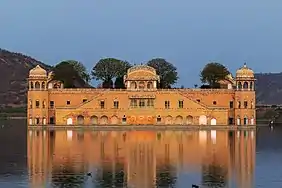
.jpg.webp)
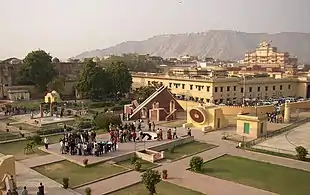
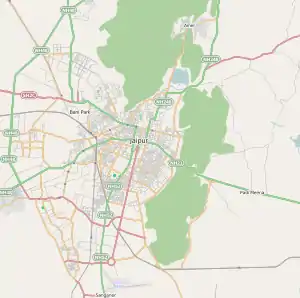
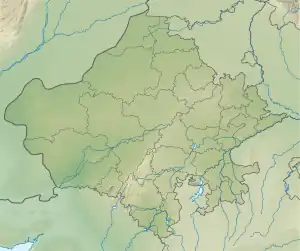


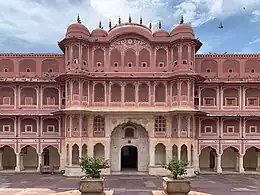
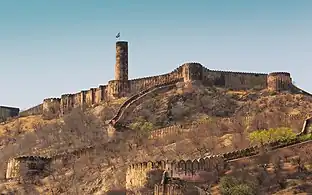
_img_02.jpg.webp)

